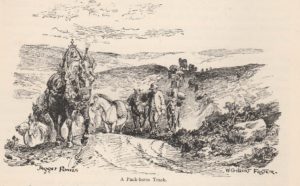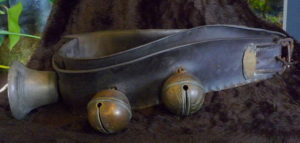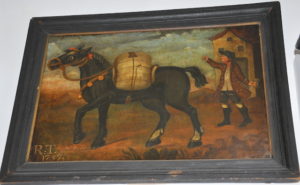After a swift AGM and the appointment of a new Chairman and Treasurer and big Thankyou to David Taylor our retiring chairman for all his work over many years and a thankyou to Roger Grimshaw for his work as Treasurer for several years and for dragging the Friends into the 21st Century, the group enjoyed a talk by Maggie Dickinson.

The lead/bell horse. Jagger Ponies W Gilbert Foster. Attribution: M. Dickinson
Maggie is a speaker who is totally in control of her subject and she mesmerised her audience with her knowledge of Pack Horse (PH) Bridges and routes. She recounted that most of these bridges were built between 1050 and 1750 and that they were no more than six feet wide and had low sides in order to accommodate the panniers. They were built without using lime mortar. The head horse often wore PH bells which gave off a different sound depending on which way the horses turned. Useful on a dark, misty day on the moors. Sometimes the ponies were known as ‘limegals’ after the burden they carried. Coal, iron, lead and other materials were also transported by these busy routes. In Clitheroe before 1750 over a 1,000 packhorses a day passed through the area.

Pack Horse bells on collar. Attribution: Margaret Dickinson
Galloway Gate at the top of Dentdale was named after the Galloway ponies. The name causeway comes from the French causies and there is a causeway from the top of Cliviger to Heptonstall, the cloth was carried to the Piece Hall there.
The wool carried by packhorses was important to the survival also of towns like Kendal, their motto being ‘Pannis mihi Pannus’, meaning’Wool is my trade’. Robert Tebay was a major carrier and his influence in the tradse is to be noted in Kendal Museum today. Kendal Green was a famous cloth known widely for its quality. Some ancient glass can still be seen in the Carriers Arms in Kendal. Netherbridge was enlarged and pantage paid in the 1300’s and apparently Kendal bowmen were present at the battles of Crecy, Poitiers and Agincourt.

Robert Tebay in the collection of Kendal Museum. Attribution M. Dickinson
Salt was another import PH commodity, witness areas known as Salterforth, Barnoldswick. Cross Cannonby Saltpans was where salt was gathered and then transported and today you can see the grave stone of a salt tax collector in the church there.
Maggie was a most interesting speaker and the audience were very appreciative recipients of her knowledge she has an amazing recall of many PH tracks and paths, many of them within the local area.
The coming of the turnpike roads, canals and railways saw the demise of the PH routes, goods were shifted more quickly and cheaply leaving tracks and paths, for those who are not aware of PH routes, with something to puzzle over.
And did you know?
Over 3,000 pairs of hand knitted woollen stockings were made every week in the Kendal/Dent area in the 18thC.
That the well known and photographed Ashness bridge is also a well known PH bridge.
We saw a rare photograph of the Cloth Hall at Colne.
Drovers and PH men were two separate entities.
Packhorses would have carried graphite known to be the finest in the world. Witness the development of the Lakeland Pencil Company. This was under the control of the Mines Royal in the 17th C.
Banner Image: Old Pack Horse Bridge, Carrbridge. Attribution: Gordon McKinlay